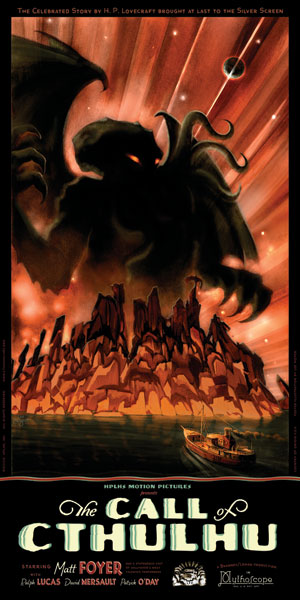Here’s an interesting tidbit. Last night I watched The Call of Cthulhu, a short independent film by the H.P. Lovecraft Historical Society. The concept was to adapt Lovecraft’s famous short story in the style of the era in which it was written–that is, a 1920s silent movie.
I actually requested Netflix add the title to their collection, and they quite nicely obliged me (which was no doubt a better boon to the filmmakers than if I’d just bought my own copy). That said, I was wary; the concept seemed ambitious and I’d already seen more than one bad, low-budget Lovecraft adaptation.
But The Call of Cthulhu impressed me. The silent film conceit works well for Lovecraft’s writing style, which is low on character development and features lots of oblique references and impenetrable dialogue. The acting is surprisingly good, perfectly capturing the stage-like style of the period, and rarely seems amateurish. Most importantly the cinematography and film stock give the impression of an actual 1920s silent film, rather than a black-and-white student film that happens to have no dialogue.
The special effects are interesting too, particularly the Impressionistic manner in which the filmmakers present the “non-Euclidean” architecture of R’lyeh, Cthulhu’s sunken city.
The film is only fifty minutes long and well worth a rental, especially if you’re a Lovecraft fan. I may end up buying a copy for myself. While this isn’t the most realistic adaptation of Lovecraft, it is one of the most effective and faithful to the spirit of the work.

Neat! Into the Netflix queue it shall go.